Pink living room ideas – 10 creative ways to use this enchanting hue
Discover these innovative pink living room ideas for a lively, characterful interior
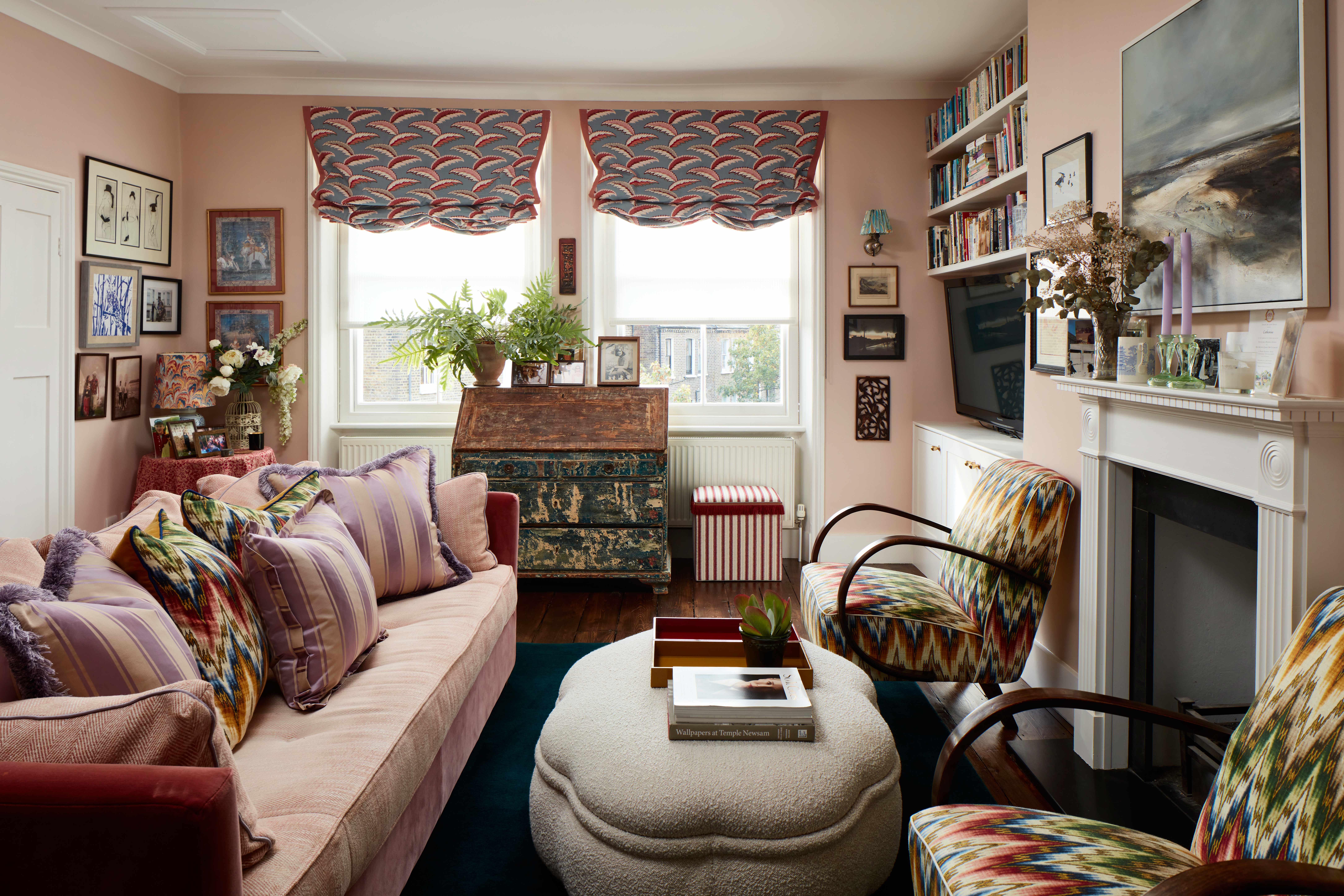

Pink living room ideas can be fresh, modern, and delightful, whether you choose a soft blush or a sizzling shade.
From coral, magenta, and raspberry to soft pink and pastels, there are several ways to use pink as a living room color idea to add an unexpected punch. The color is fun and flattering, whether used in bedrooms, a sophisticated office space, the hallway or living room.
'Pink is a great option for a living room because it hints at retro but also continues to be modern,' says Jennifer Morris, Brooklyn-based interior designer and founder of JMorris Design. 'Lights reflecting off pink walls lend richness to the overall tone of the room. This color can be used to create an intimate vibe or help prepare for a relaxing night’s sleep. If you're afraid of pink it can simply be an accent wall, a chair, or tones in a rug.'
If you too are intrigued by this luscious color, then these ideas by top interior designers and color specialists will tell you all you need to know. Here's how to use the color in wallpapers, paint, and accessories with panache.
10 pink living room ideas to inspire your project
1. Consider softer shades for a space-boosting effect
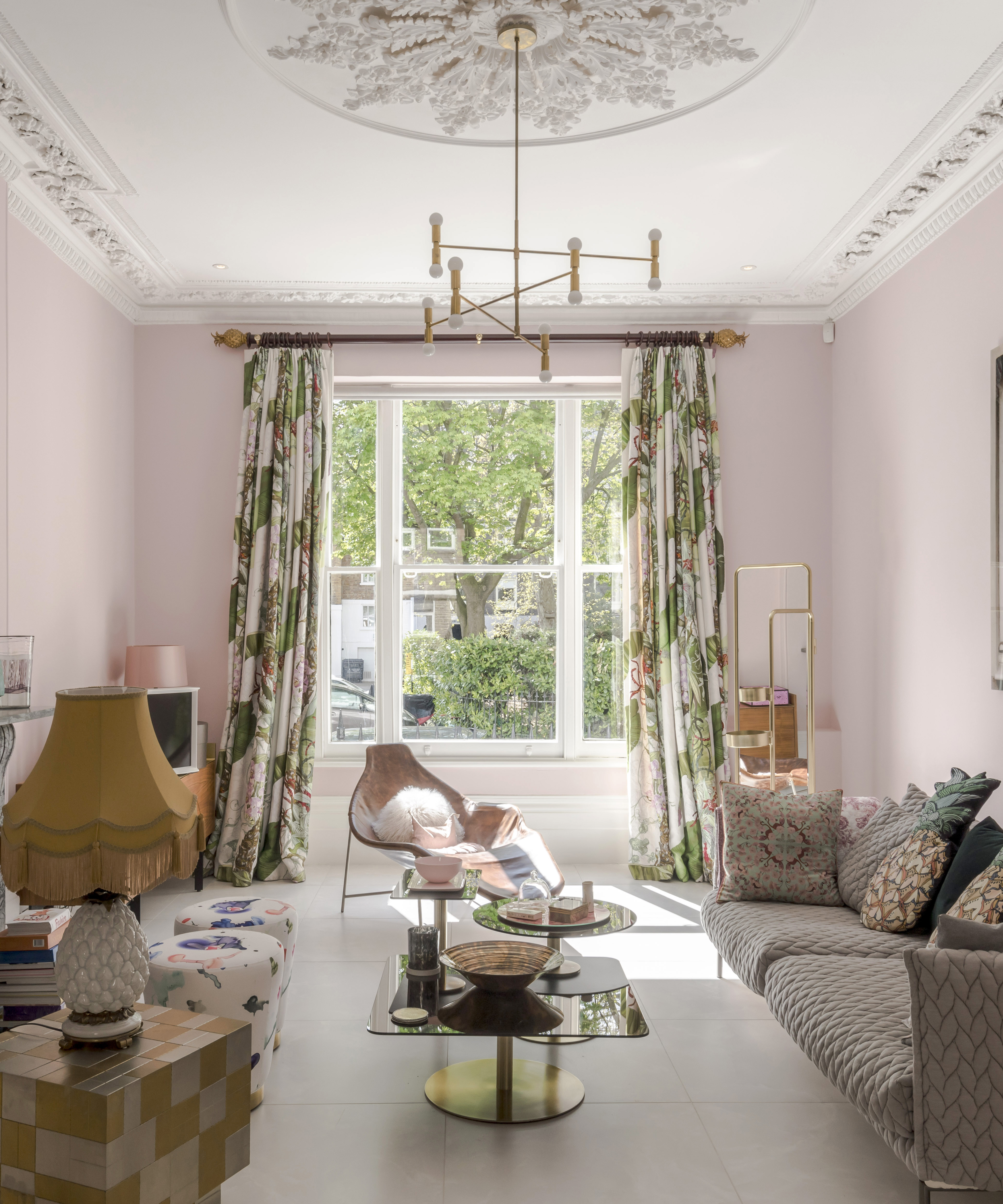
Pink is generally considered a bright, energetic color, but there are softer versions of this color can be experimented with to design an elegant living room. A soft pink can work as a neutral, as it is a more interesting alternative to beige and can be a good background for artwork and other materials.
For this, you need a less saturated hue of pink, tinted with white. The color can help bounce the natural light around the room and make the living room a bright, airy space.
Notice how in this living room, the pink may be subtler than some other pinks, but it’s not trying to hide. It easily takes over the space and complements the off-white ceiling as well.
'It is just a small step away from a neutral palette and therefore easy to introduce to a space, yet instantly brings interest and character without being overwhelming,' says Caroline Milns, interior designer at London design practice Zulufish.
'Combine it with white for a timeless, modern palette or add a pop of a contrasting shade to surprise and delight. Moreover, it is a color that fills a room with a soft, suffused glow, which in turn brings warmth and flatters skin tone,’ Caroline explains.
2. For a glamorous living room, choose raspberry
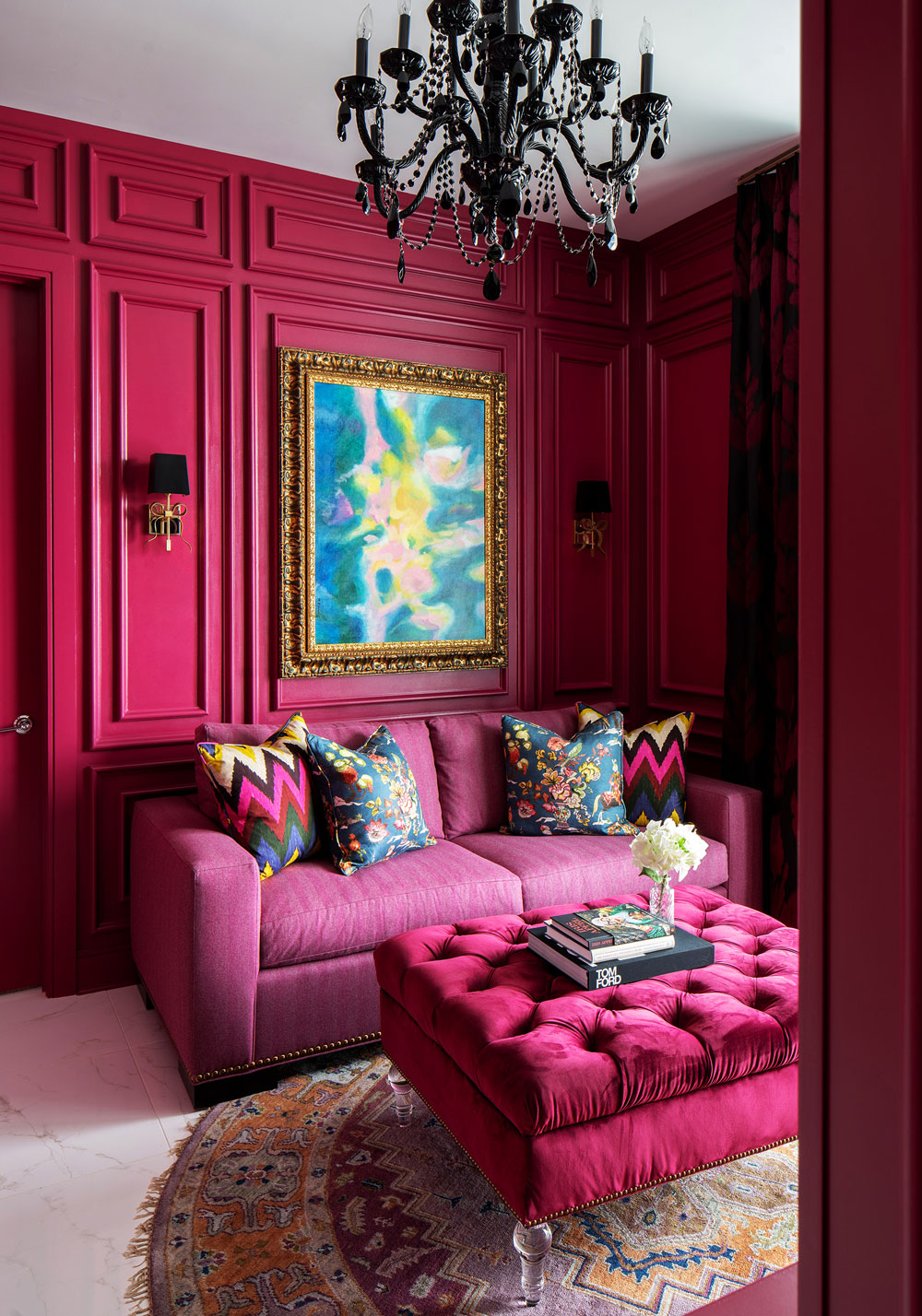
Raspberry pink is a gorgeous tone – in fashion, it's seen aplenty. But in interiors, it can be a daring color to use. Raspberry is more on the red side and so has a dominating, high-energy effect.
Dark wood, dark grey, and metallic tones ideally make brilliant pairings for a glamorous effect. If you want to bring this tone via furnishings, large prints can give added weight to this look. A bright raspberry also makes for a great tone for color clashing and creating an eclectic look for designing a modern living room. Pair it with charcoal grey, black, or even green for an eye-catching effect.
'For a bold look, deep magenta balanced with cream woodwork or paneling offers classic glamour,' says Helen Shaw, Benjamin Moore UK Director. 'Pair pink paint with white, greys, and neutrals, or create contrast with deep brown or black, revealing the versatility of this color.'
'Blush, coral, fuchsia – pink paint offers a surprising range. Depending on how you use it, pink can provide interest and offer a subtle blush of color that not only warms a room up but also feels positive and welcoming,' says Helen.
3. Contrast pink with other complementary colors
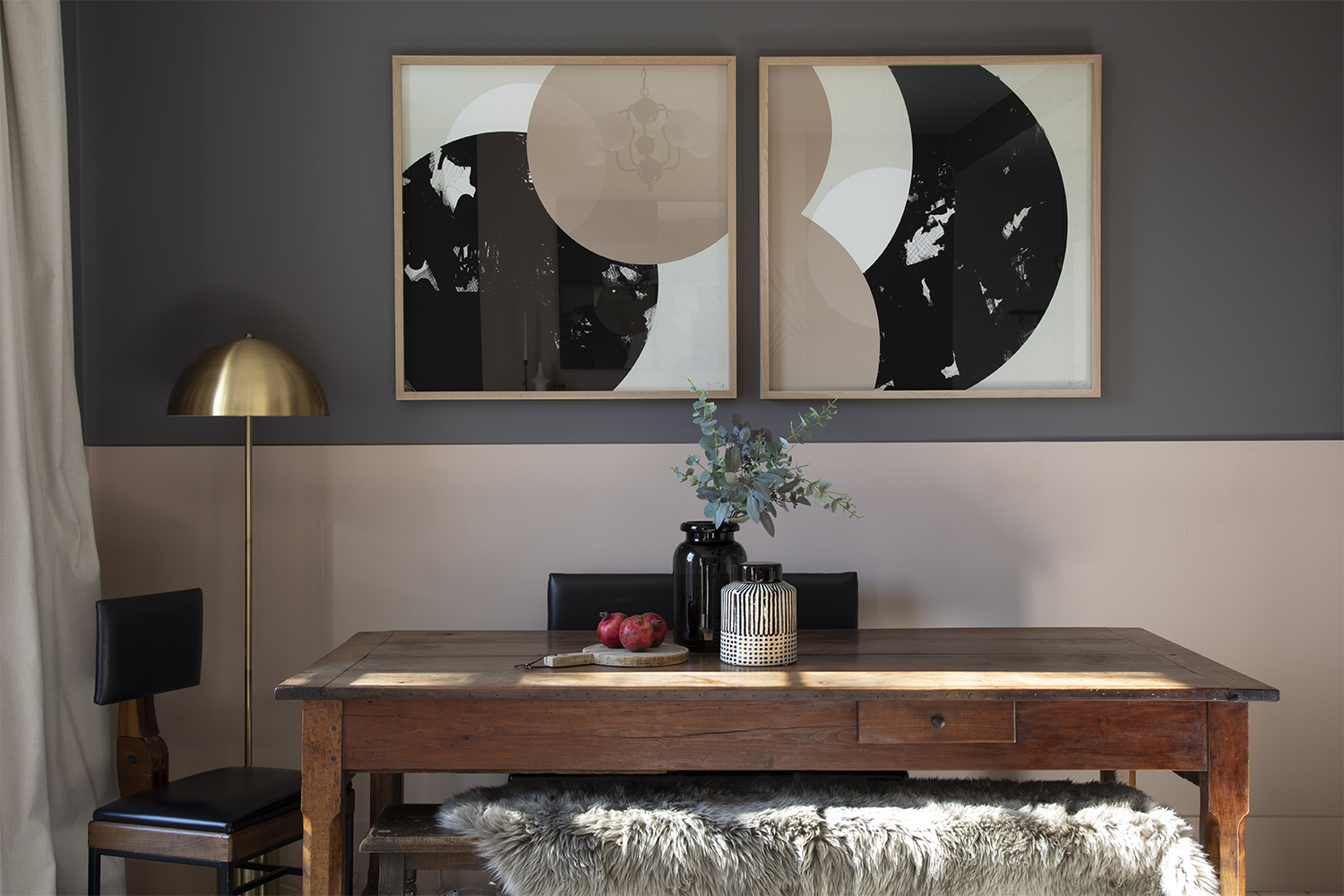
The days of pink being regaled to bathroom suites and nurseries are long gone. The color has a strong personality and is used confidently in interiors. It is versatile, and there are several colors that go with pink.
While pinks can easily work in almost any scheme, there are a few shades they work best with. For instance, dark navy blue and deep pink work well in a contemporary setting. Sage green and light blush pink can create a more subtle feeling.
Grey and pink make the most striking combination, especially in a more industrial setting where grey acts as a neutral while pink helps lift the grunge scheme. In rustic interiors, remember, blush pinks are more suited when used as a backdrop to concrete and metal.
'Interplay between feminine and masculine shades is used to divide the high walls in this townhouse in London,' says Mimi Pearce, senior interior designer, Run For The Hills. 'The dark art is softened with the blush pink Temple paint color with a moodier grey Monument sitting above, both from Paper & Paint library.'
4. Color block your living room with this blush tone
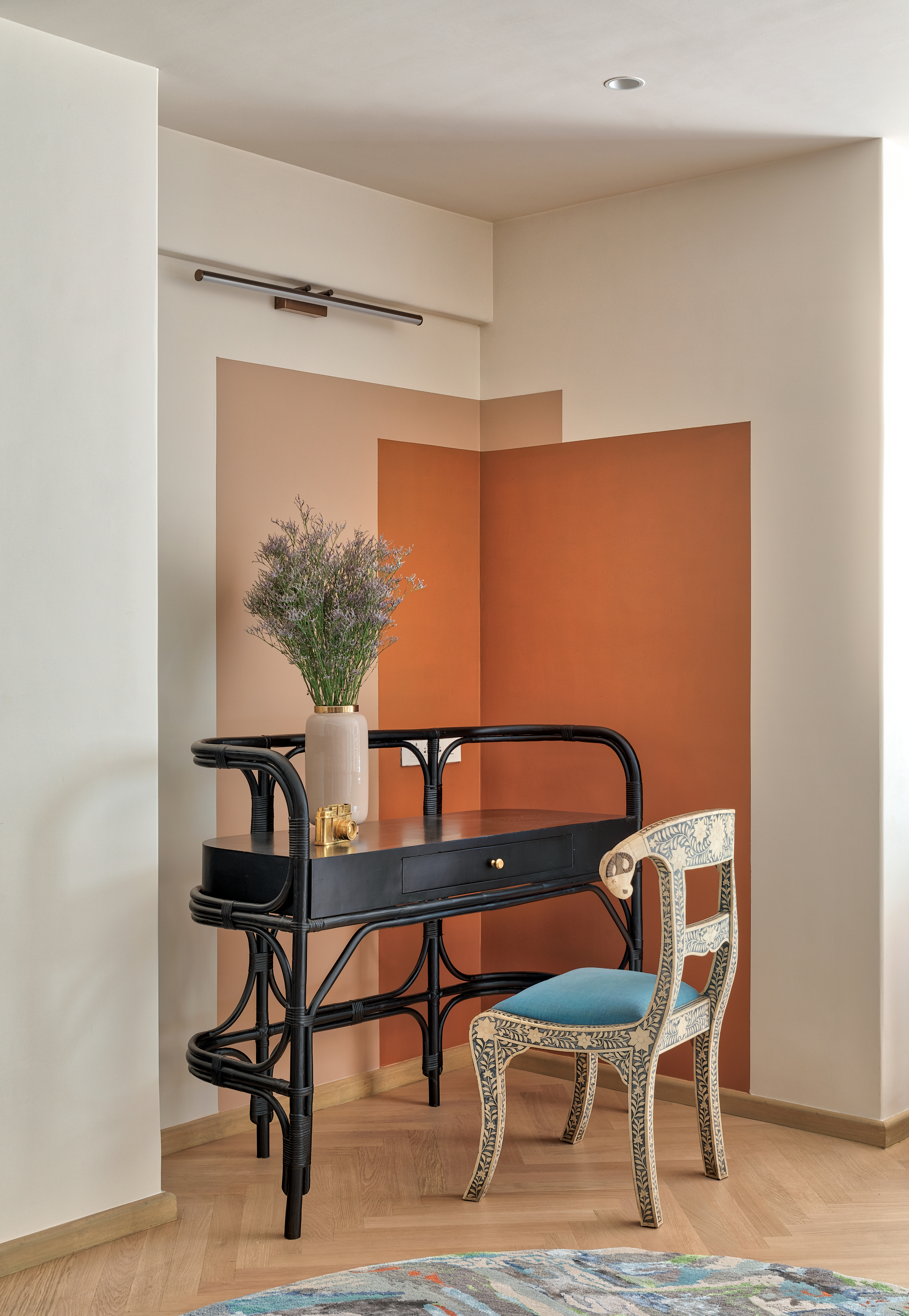
Color blocking is a way of pairing different solid hues together to create a striking space. A great thing about this idea is that you can implement as many or as few colors as you want. It can be done with subtle shades too. If you're redesigning a living room, one way to glam it up is by color blocking. Experiment with colors that appeal to you and come up with a palette that easily flows into the space. Try to match the unmatchable and use accessories to unify the shades.
'The wall colors in this space were inspired by an Arizona desert color palette,' says Noorein Kapoor, interior designer, Noorein Kapoor Design. 'We worked with color blocking in this corner with Dawn - 0469 over a base wall color called Macadamia-5184 and then overlapped it with the darkest color called Copper Leaf - 0523, all from Asian Paints. By using color blocks and by working within a corner, we added more character to the space and made the entire house look interesting.'
5. Pair wooden elements with dusty pink for an earthy scheme

Drenching walls in pink is a living room trend that's growing in popularity. The good thing is, you don't have to choose extremely saturated hues to add oomph to a space. Soft, barely-there tints too can give the space a fresh vibe too.
Think about materials you match pink with too. For a calm, restrained interior, balance powder pink walls with touches of warm neutrals – sand, stone, caramel. Softer pinks can be a cool tone, so natural wood warms it up.
To enhance the earthy look of the room, play up the textures with linens, woven accessories, and ceramics that won’t look dated.
6. Introduce dusky pink in a patterned wallpaper
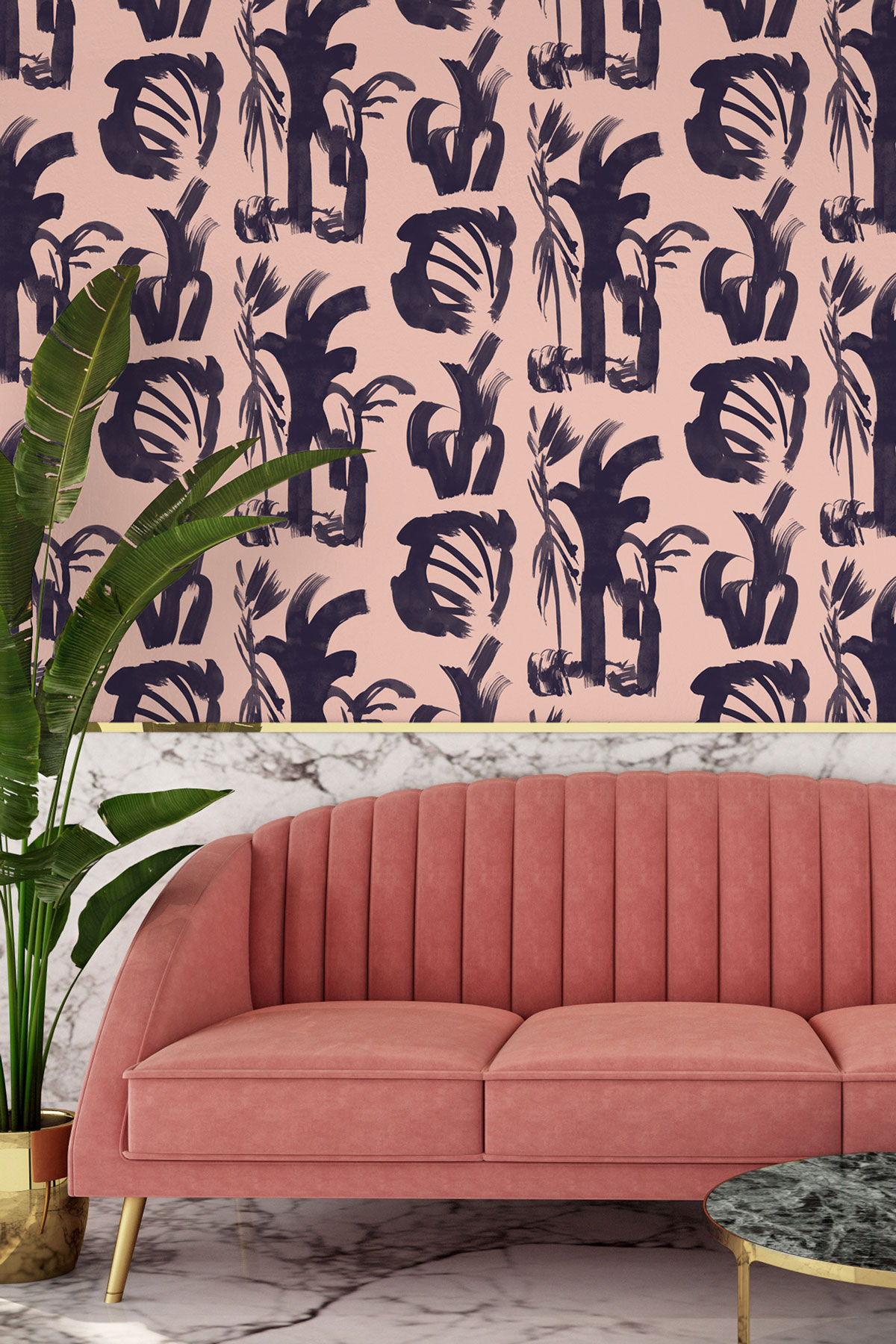
Don’t be afraid to go bold with your living room wallpaper for fear that it won’t suit a pink living room. A complete contrast in furniture and wallpaper choice can be very grounding, giving definition to the pieces and adding depth to the overall scheme.
If you're worried your living room may look too sugary sweet, opt for a pattern with dusky shades of pink and texture. Take it as dark as you can without doing away with pink tones.
Consider adding taupe living room curtains and muted metallic accents for a more contemporary vibe. For a warmer feel, contrast the pink wallpapered wall with grey floor tiles.
7. Add pops of rose pink with a rug
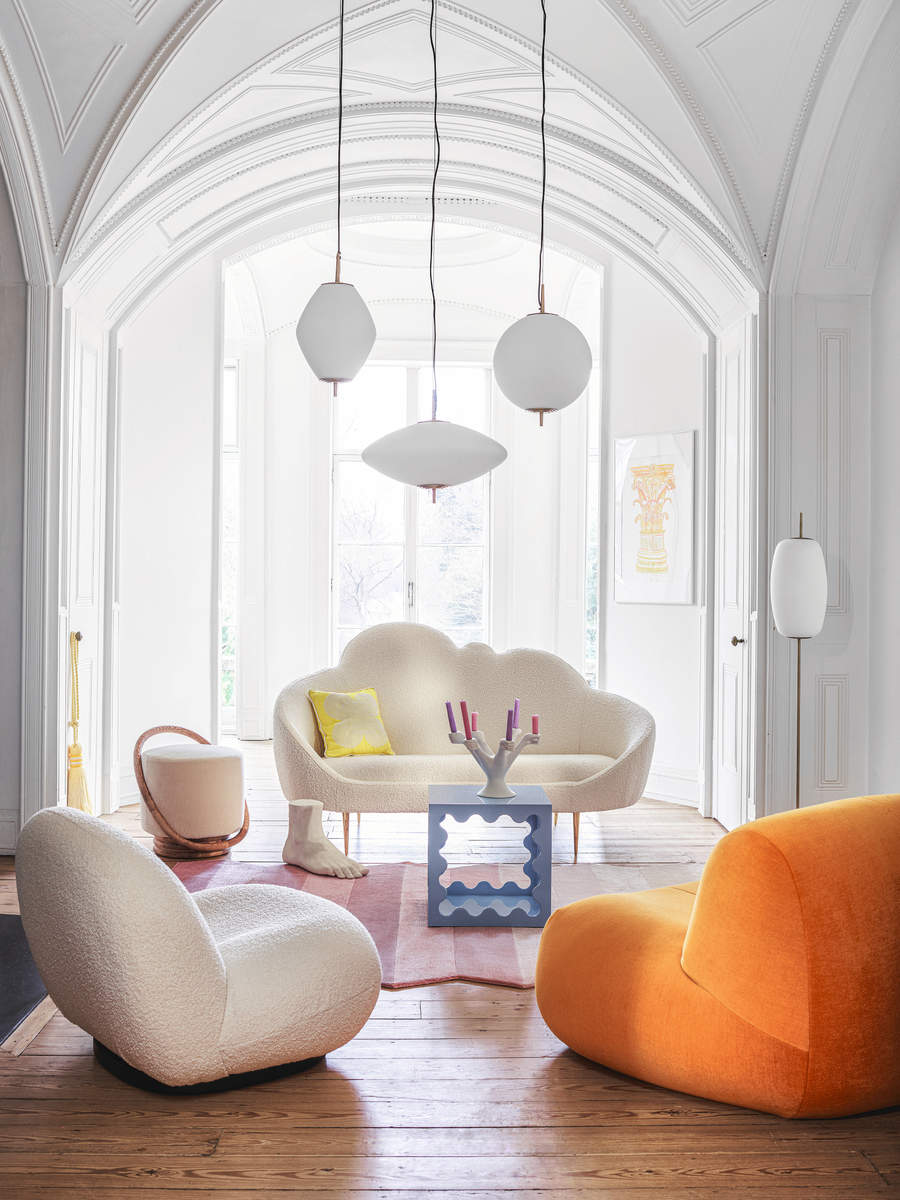
You can love pink yet be unsure of how to use it. If that's the case, consider throwing a coat of paint on an accent wall, on one piece of living room furniture or introducing the color through upholstery.
You could even paint just the window frames in a pink – this will help draw attention to the living room without competing with the gorgeous window views.
'One way to incorporate pink in a living room is to do so from the bottom up with a rug,' says interior designer Natalie Tredgett. 'Once the pink rug has grounded the space, you can then layer other colors and pieces to the pink base steering the room away from feeling too soft or like a bedroom.'
8. Try plaster pink for wall decor
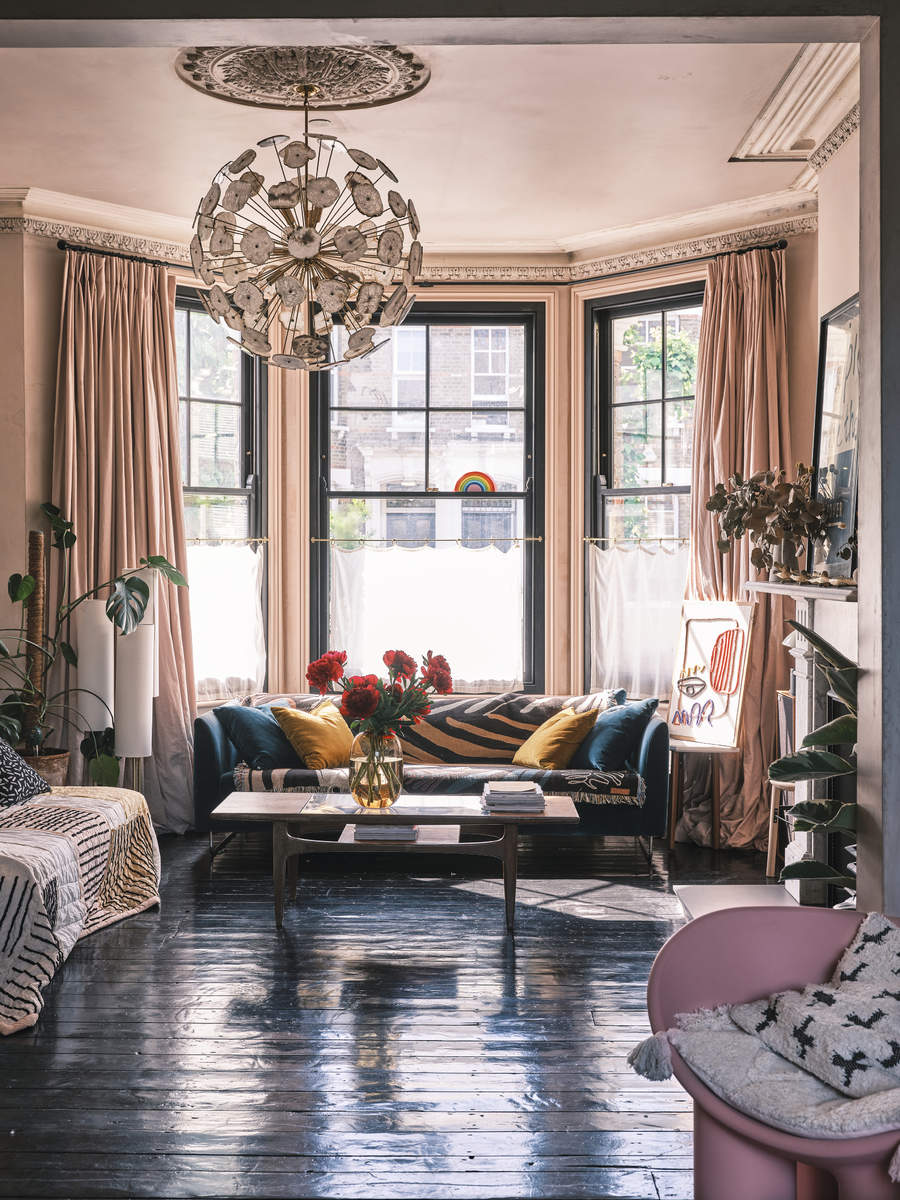
'Pink is perfect for a living in which you want a look that is joyful and uplifting. Pink can be a bit cheeky but it's ultimately warm and super relaxed,' says Marianne Shillingford, creative director of Dulux. 'Pink captures a sense of gentle fun and is perfect for warming up north-facing rooms where soft pale shades with just a hint of apricots like Blush Pink, Powder Colour and Spring Rose look amazing teamed with lots of houseplants and verdant green accessories.'
If you want to bring some movement and flavor to the look of your modern rustic living room, consider raw plaster or textured walls that have a rough, uneven surface. The paint comes from the additives like silica sand or gypsum.
This will give a defining the look and feel to your home. While textured paint adds character, it also helps to hide imperfections in a room. It can cover uneven surfaces, tricky cracks, or dents and make the space look organic and tactile.
9. Experiment with layering this rosy hue in your palette
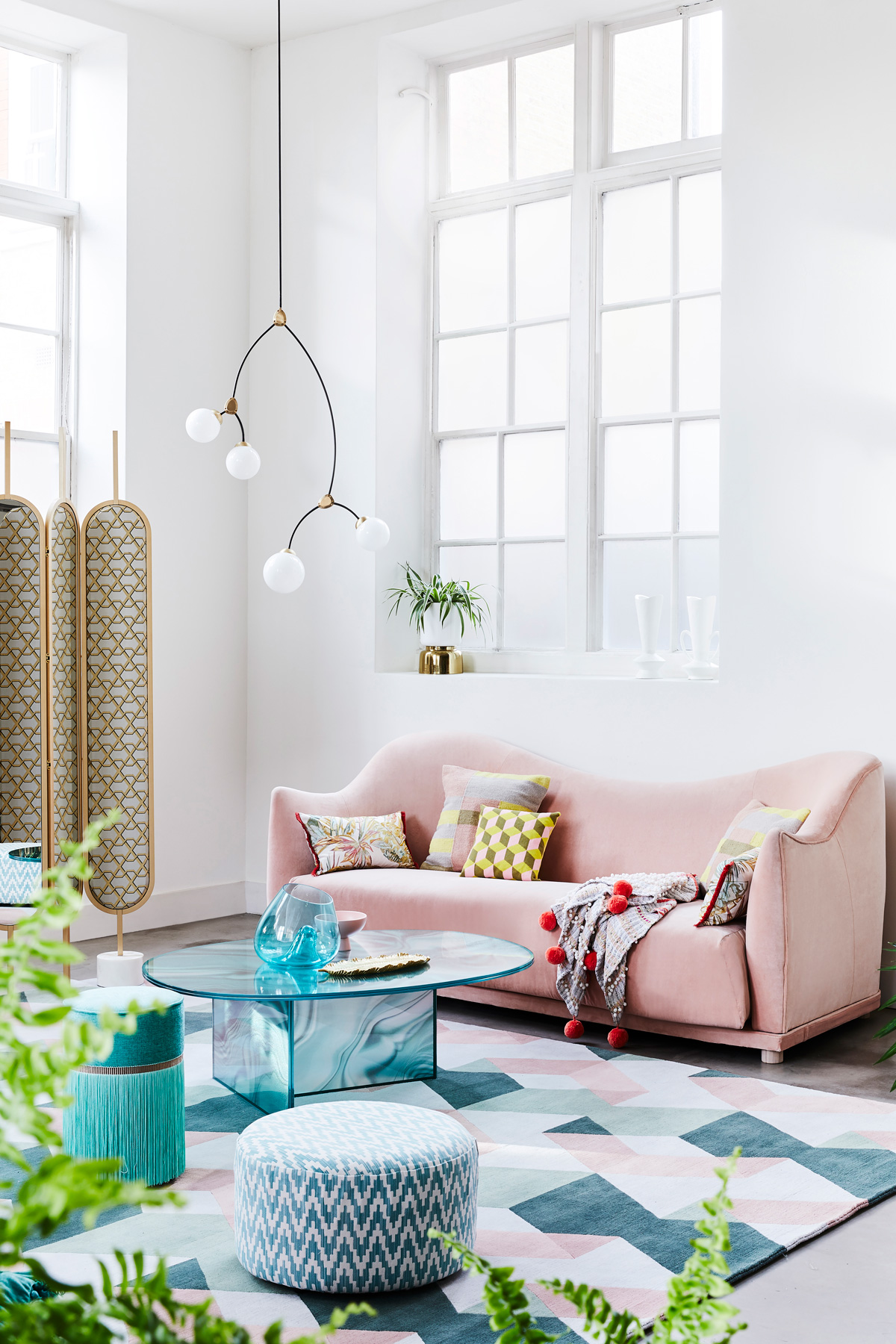
The art of layering is not only using a single shade on various surfaces in an interior but also making them work together cohesively – building the room from the ground up.
Choosing the overarching color is the first layer to consider. While most people think of whites and creams as the background color for a space, any single color in a room also works in the same way. When it comes to painting ideas, start with a soft paint color. The color, in this case, soft pink, will work as a canvas to build the entire theme.
Adding a pattern is the next step. Bring in patterns via the upholstery, perhaps on the living room window treatments, on cushions, rugs, or occasional chairs. When layering, make sure you go from pale to dark around the room and use two to three different tones of the same shade.
Another layer can be the lighting ideas in the living room. Choose the right fixtures to ensure all the architectural and design features of the room are highlighted, from ceiling to floor. In a large living room, bring in a whole range of lighting sources - pendants, recessed lights, chandeliers, track lighting, floor lamps, wall sconces, and spotlighting.
The last layer is the accessories. Vases, curios, and flowers reflecting pink work as the cherry on the cake. 'Depending on how you use it, pink can provide interest and offer a subtle blush of color that not only warms a room up but also feels positive and welcoming,' says Helen.
'Pink will feel particularly cosseting in smaller spaces and works well in north-facing rooms to create mood and interest, working with what light is available,' says Helen. 'South-facing rooms that benefit from lots of natural light can overwhelm soft neutrals when paired with bold, saturated hues. Layer soft pinks, blush, and taupe shades.'
10. Add dark pink to your living room in unexpected places
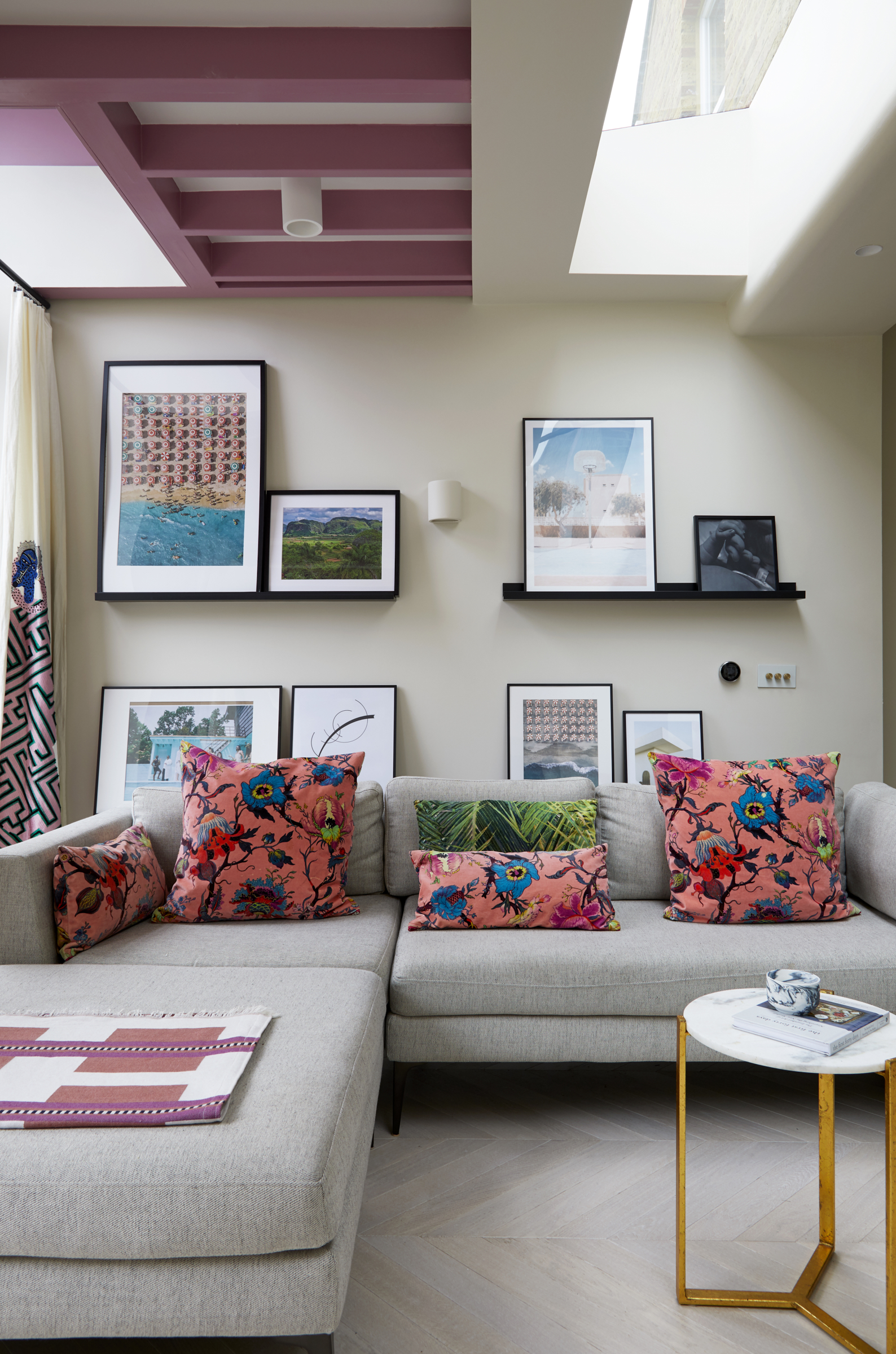
Using just a touch of pink can add to a cozy living room. A great way to subtly bring in this color is by painting the ceiling beams this hue.
This is a wonderful way to accentuate the architectural features of a space and to even bring the room's height into focus. Note, if your ceiling is too high and you want to visually bring it down, paint the ceiling one foot down onto the wall. The room will look much cozier.
In this living room, the lilac-pink ceiling cocoons the largely muted room where the cushions chosen in a similar color palette brings cohesion to the overall scheme.
Is pink a good color for the living room?
Pink is a timeless color and has been receiving love for decades. In some way or the other, pink can easily make its way into homes, either through cushions, accessories, or artworks.
If you are keen on having a dominant pink palette, don't use more than three tonal shades. Using white as the base will help you build the interior better, without making it look garish.
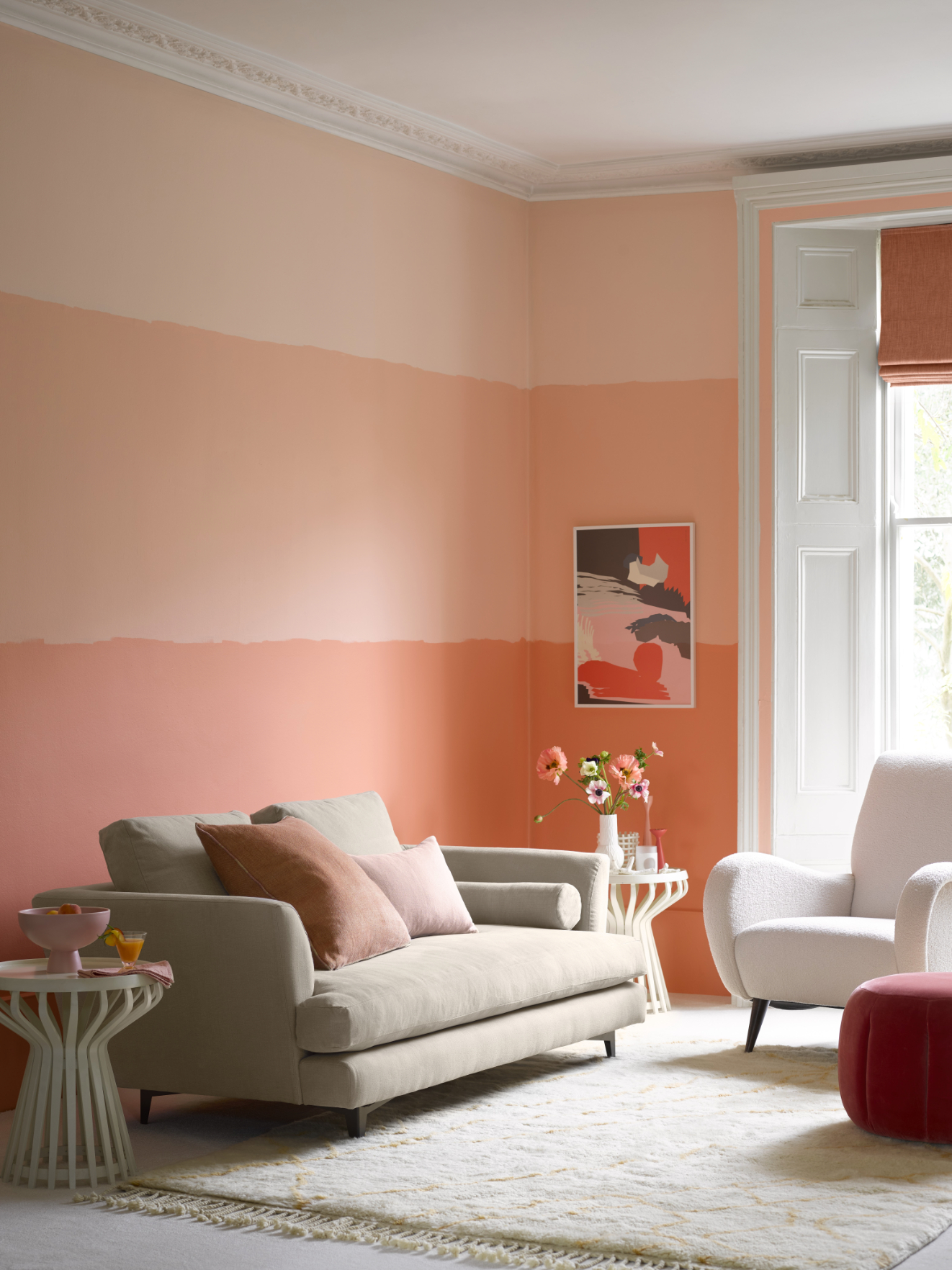
If you're open to a more daring scheme, then you could choose the pinks at the opposite end of the spectrum like raspberries, hot pinks, and deep magenta. These pink paints look great with contrasting accents such as grey and black.
'Make a statement with tonal ombre bands, expressive shapes, and soft curves. Choose a tonal palette of three colors with varying depths to achieve this easy ombré effect,' says Helen.
How do I use pink in my living room?
Pink can be incorporated into the living room in several creative ways. The first of course is through paints. You can choose a soft pink palette and paint your walls and even the ceiling in this hue to give the room a cocooning effect. Remember that this works best in a large room that receives plenty of sunlight, otherwise a fully pink painted room can be seen as daunting after a while.
'If going pink on the walls is too much, you can find paint colors with pink undertones. I have Benjamin Moore White Opulence in my living room and I see hints of pink in it, depending on the quality of light and time of day,' says Jennifer.
The other way to experiment with pink is through fabrics. Inside a neutral room, a bright pink occasional chair, or a nest of pink cushions looks best. Consider ombre sheer curtains that throw colored light inside the room. If nothing else, a raspberry-toned throw can do the job.
You can also bring in pink via accessories. This can help create a layered effect, where a room with pink accents and accessories helps disperse the boldness of the color across the space, giving the interior a breather.
Finally, consider coloring only the joinery or trims in the space the color pink. This will help you induce the color subtly and add some uniqueness to the overall scheme of the room.
'Having pink as part of a pattern in the fabric, perhaps the drapery or rug is recommended. Even a pop of pink on a pillow could change the ambiance of a space,' says Jennifer. 'Pink has feminine connotations in our culture but it’s a flexible color and I think it’s a great balance with green, tobacco colors, blues, and blacks.'
Be The First To Know
The Livingetc newsletters are your inside source for what’s shaping interiors now - and what’s next. Discover trend forecasts, smart style ideas, and curated shopping inspiration that brings design to life. Subscribe today and stay ahead of the curve.

Aditi Sharma Maheshwari started her career at The Address (The Times of India), a tabloid on interiors and art. She wrote profiles of Indian artists, designers, and architects, and covered inspiring houses and commercial properties. After four years, she moved to ELLE DECOR as a senior features writer, where she contributed to the magazine and website, and also worked alongside the events team on India Design ID — the brand’s 10-day, annual design show. She wrote across topics: from designer interviews, and house tours, to new product launches, shopping pages, and reviews. After three years, she was hired as the senior editor at Houzz. The website content focused on practical advice on decorating the home and making design feel more approachable. She created fresh series on budget buys, design hacks, and DIYs, all backed with expert advice. Equipped with sizable knowledge of the industry and with a good network, she moved to Architectural Digest (Conde Nast) as the digital editor. The publication's focus was on high-end design, and her content highlighted A-listers, starchitects, and high-concept products, all customized for an audience that loves and invests in luxury. After a two-year stint, she moved to the UK and was hired at Livingetc as a design editor. She now freelances for a variety of interiors publications.
-
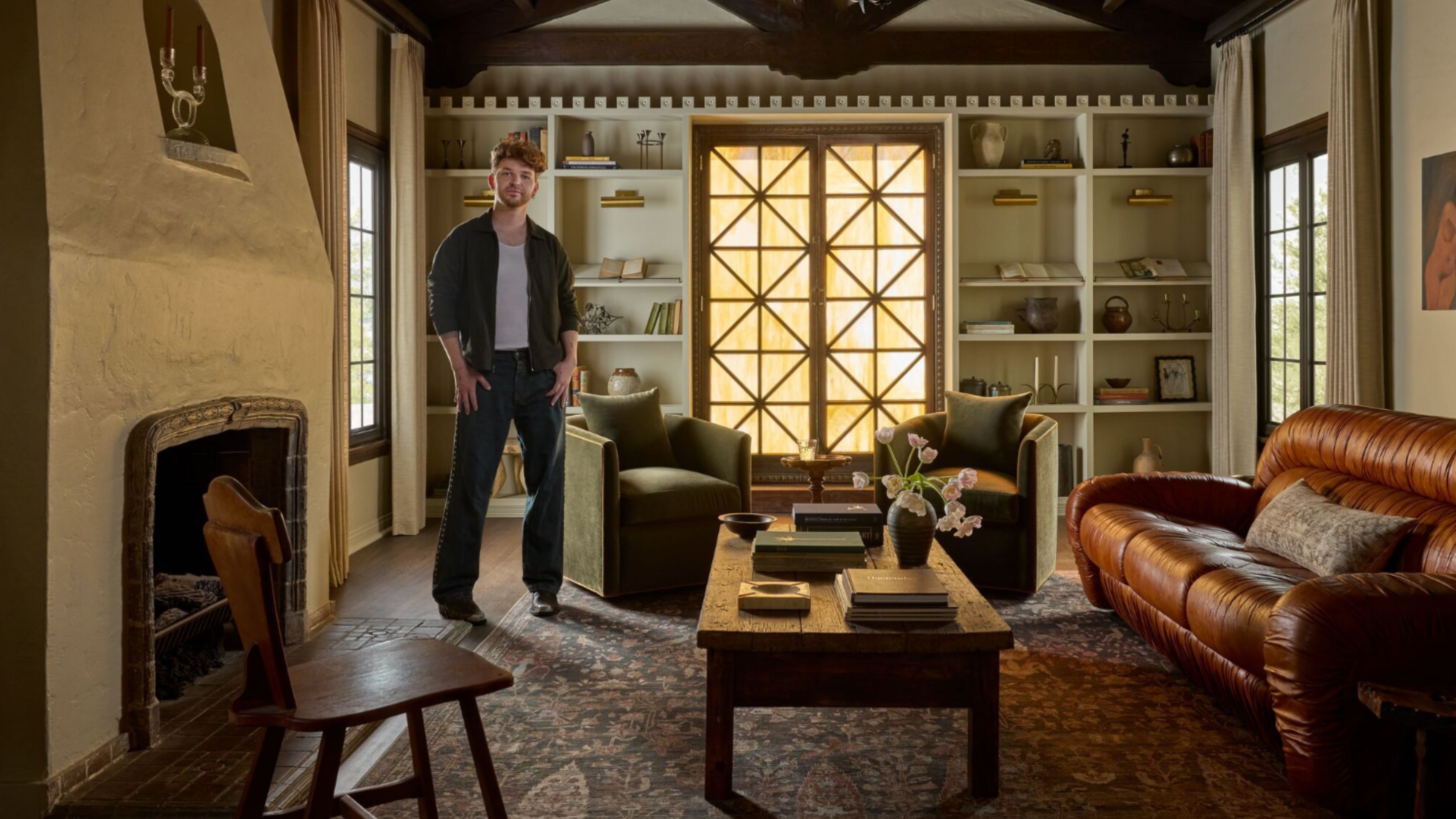 Lone Fox's Drew Michael Scott Drops a Vintage Capsule with Joon Loloi (And Some Seriously Good Tips For Thrifting Antiques)
Lone Fox's Drew Michael Scott Drops a Vintage Capsule with Joon Loloi (And Some Seriously Good Tips For Thrifting Antiques)Sourced straight from one of the world's biggest antique shows, Drew shares how to stay sane, cut through the noise, and score what you actually want
By Julia Demer Published
-
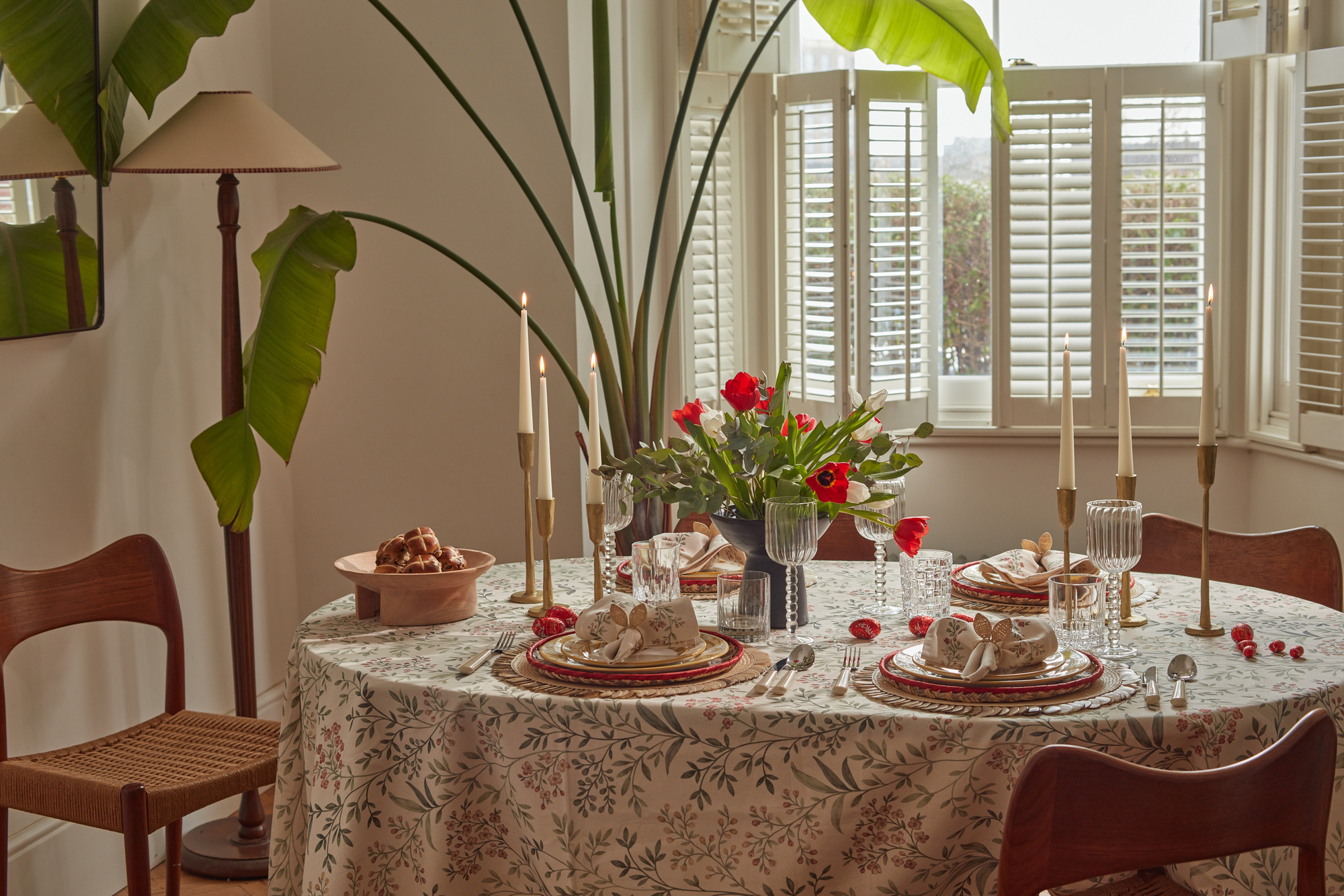 9 Easter Table Decor Ideas to Plan Now for Perfect Tablescapes This Season
9 Easter Table Decor Ideas to Plan Now for Perfect Tablescapes This SeasonFrom centerpieces and color schemes to tablecloths and seasonal themes, let these designer-approved ideas inspire your table styling this Easter
By Lilith Hudson Published